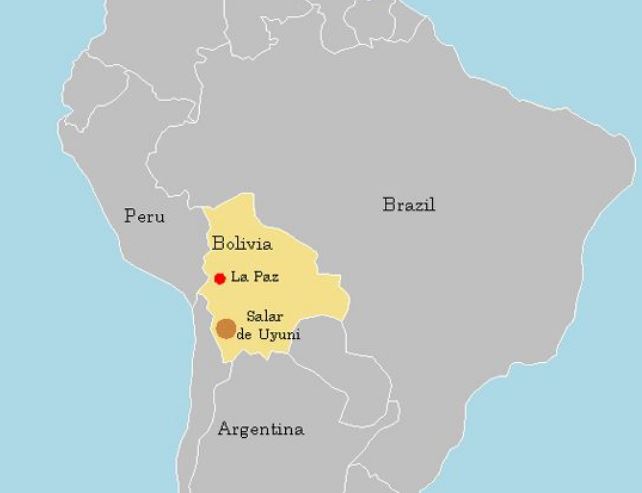Salar de Uyuni, amid the Andes in southwest Bolivia, is the world’s largest salt flat. It’s the legacy of a prehistoric lake that went dry, leaving behind a desertlike, nearly 11,000-sq.-km. landscape of bright-white salt, rock formations and cacti-studded islands. Its otherworldly expanse can be observed from central Incahuasi Island. Though wildlife is rare in this unique ecosystem, it harbors many pink flamingos.
Salar de Uyuni is one of South America’s most phenomenal attractions. The vast expanse of white, glistening salt stretches across 10,582 kilometers of the Altiplano and can even be seen from space. Layers of salt are sandwiched between sedimentary deposits that reach a great depth of 10m in the centre of the flat. In total there is an estimated 10 billion tonnes of salt here. However, the real treasure for the locals lies beneath the salt flat, where approximately 70% of the world’s lithium reserves can be found. An entire industry has been devoted to the extraction of this light metal which is responsible for powering laptops, smartphones, and electric cars.




An array of jaw-dropping sites surround this marvelous landscape to produce one of the most extraordinary and unforgettable tours you will ever experience. This magical corner of the world is complete with vibrant colored lakes, bubbling geysers, crazy rock formations and quinoa producing villages. Although it attracts many visitors, it remains one of the world’s most unspoiled and natural landscapes.






The Cañapa Lagoon is a beautiful water mirror of a greeny tint surrounded by Andean flora and it is possible to observe some flamingoes, wild vicunas and some Andean geese. Cañapa Lagoon is surrounded by three volcanoes: Caquena, Tapaquillcha and Canapa.




Laguna Hedionda is named the stinking lake because of the sulphur that comes out of it, this lake doesn’t have the distinctive bright colors of some of the others here on the list, but it does have flamingos!
The flamingos that appear here and at the Laguna Colorada are part of a separate that are very rare–it’s often thought that they were extinct in the mid-1950s but they still exist in small numbers in the Bolivian altiplano. So, even though they seem to be omnipresent at the Lagoon they are quite endangered.














- Measuring at 10,582 km, Salar de Uyuni is the biggest salt flat in the world.
- One of the most popular attractions in Salar de Uyuni is a cemetery for trains! It contains all the trains that were used in mining during the 1940s and currently attracts thousands of tourists every year.
- At times the salt flat is covered in very clear water, making it the largest natural mirror in the world.
- Salar de Uyuni is also referred to as Salar de Tunupa or “salt flat enclosure” in Spanish.
- An estimated 11 billion tons of salt is believed to be within Salar de Uyuni.
- NASA uses Salar de Uyuni to figure out the positioning of their satellites.
- There are 80 species of birds (visiting and migrating) at Salar de Uyuni, including three species of flamingos.
- It was believed that Salar de Uyuni was completely flat, but later some small undulations were discovered on the surface.

The best and most popular way to fully experience Salar de Uyuni is by taking a 4×4 tour across the salt flats. It’s worth noting that shared tours usually accommodate for up to 6 tourists, and thus for a more comfortable experience, a private tour should be arranged. Such tours usually involve a minimum of one nights stay in rather basic accommodation, and thus it is recommended that you bring plenty of warm clothes and a warm sleeping bag for the night. Further, sun cream is a necessity as the reflections from the salt accentuate the suns effect.
Adventurous travellers may also wish to try a night’s stay in one of the areas renowned salt hotels. With no building materials around for miles, some locals have taken it upon themselves to build structures from bricks of cemented salt. In these hotels, everything from the beds and tables to the flush toilets are constructed from salt blocks. Even if you don’t fancy staying, you can usually view these hotels during the day for a nominal fee.
In the dry season, Salar de Uyuni is a surreal experience not to be missed. However, rain takes it to a whole new level. As a thin sheet of water covers the flats, it reflects a perfect representation of the sky above so that it is impossible to tell where sky ends and the land begins.
Best time to visit Salar de Uyuni
The best time to visit Salar de Uyuni ultimately depends upon the experience you are looking for. For the best climate, we recommend you visit between July and October. However, for an increased chance of seeing the reflective surfaces, you should visit between March and April.
How to get to Salar de Uyuni
Most tours to Salar de Uyuni originate from the small town of Uyuni. To get to Uyuni, you have a number of options available to you. Most people choose to travel from Ororo, where it is 7 hours by train, or 8 hours by bus. These tickets are quite often booked up on the day, so it is recommended to book in advance. Alternatively, you can take a bus from La Paz (12-15 hours) or Potosi (6-7 hours). Lastly, you can choose to rent a car or fly into Uyuni’s small airport from La Paz.




